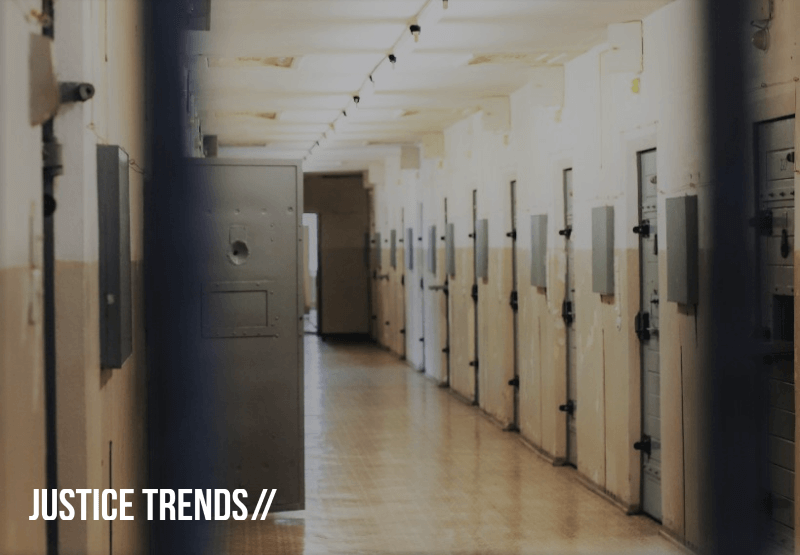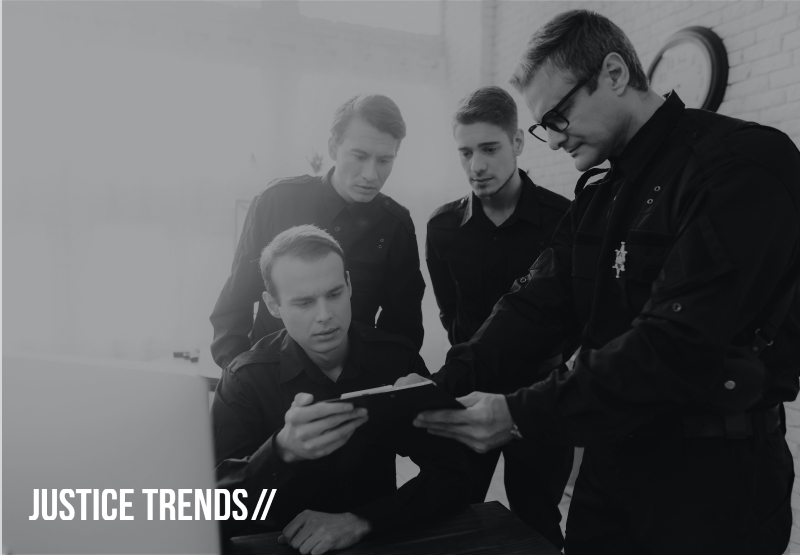
Understanding radicalisation, dynamic security and intelligence in prisons
Over the last 10 years, violent extremist (1) offenders (VEOs) have conducted several incidents analogous to some form of extremism, such as Islamist-related violence and anti-immigrant movements (van Heelsum & Vermeulen, 2018).
While the latter type of violence – although not excusable or justifiable – is a form of response (2) of some extreme right-wing, Western society individuals, the former type is associated with radicalised individuals that aim to spread out their ideology through violence and fear, publicising an escalation on the climate of terror.
As it is widely known, the frequency of these violent acts (either foiled or successful) has been trending up over the last years, making countries aware of the necessity to urge the development of efficient, up-to-date radicalisation (3) prevention strategies, where prisons have an “increasingly prominent role” (Martins & Ziegler, 2018, p. 325), especially since it has been widely claimed that violent extremist ideologies’ recruitment and – in some cases – terrorist attacks’ planning actually had its primary origins behind bars (Central Intelligence Agency, 2002; Cilluffo, Saathoff, Lane, Cardash, Magarik, et al., 2006; Her Majesty’s [HM] Government, 2013; Neumann, 2010).
Therefore, it is unsurprising that prisons are considered one of the three key areas – besides educational institutions and the internet – where the prevention of radicalisation should focus on (Martins & Ziegler, 2018). The prison environment tends to serve as the groundwork that potentiates radicalisation, since it not only leads to inmate recruitment by either already radicalised individuals or VEOs, but also due to – consequently – working as a support to strengthen extremist groups from prison and vice-versa (i.e., getting support from extremist groups outside prison) (Radicalisation Awareness Network Prison & Probation [RAN P&P], 2016a). Additionally, incorrect practices end up preparing individuals to legitimate ideological, violent extremist acts on a post-release period, besides enhancing the whole radicalisation process by failing to address inmate’s frustrations, grievances and general anger related to imprisonment – which, therefore, leads to a(n) (increasingly) hostile relationship with staff (RAN P&P, 2016a). These concerns led organisations (namely, the Council of Europe [COE]), intergovernmental organisations’ offices (namely, the United Nations Office on Drugs and Crime [UNODC]), and EU institutions (namely, the EC) to provide guidance on how to effectively tackle this issue (COE, 2016a; 2016b; UNODC, 2016; RAN P&P, 2016a; Williams, 2017).
An escalating reality
Radicalisation within prisons is not a recent phenomenon, being thought to be as old as prisons actually are (Hamm, 2011). In fact, this ‘radicalisation effect’ has produced both positive (e.g., Gandhi) and negative (e.g., Hitler (4)) extremist views, either revolutionary (e.g., Mandela; Churchill) or oppressive (e.g., Stalin) (Hamm, 2011; Silke, 2014a), which makes radicalisation within prison a “double-edged sword: prison can produce both freedom fighters, who struggle for economic and social justice by non-violent means, and terrorists, who use violence to cause a change in the social order” (Hamm, 2013, p. 14).
Unfortunately, the latter case is quite frequent nowadays, with several cases of VEOs who had undergone their process of radicalisation while incarcerated and attempted to commit terrorist attacks – some successfully – following their release, such as Richard Reid (5), Jose Padilla (6), José Trashorras (7), Khalid Kelkal (8), Kevin James (9), Levar Washington(10), Kevin Gardner (11), Muktar Ibrahim (12), Chérif Kouachi (13), Amedy Coulibaly (14) and Abu Bakr al-Baghdadi (15).
Besides these examples, the case of Ayman al-Zawahiri is illustrative on how the adoption of null or counterproductive strategies in prison might lead to or increase one’s predisposition to becoming a VEO, since he “was already a radical before (entering) prison, but when he emerged, he had become even more committed to the cause and considerably more dangerous and powerful.
His prison experience served only to harden his zeal; he became a leader among his fellow inmates and emerged as a prominent spokesman for the cause. Upon release he assumed the overall leadership of Egyptian Islamic Jihad, committing that movement to a campaign of extreme violence, and ultimately merging the organisation with al-Qaeda in the 1990s.
Prison did not reform Ayman al-Zawahiri, it did not rehabilitate him, and it certainly failed to de-radicalise him. It only succeeded in making him more dangerous” (Silke, 2014b, p. 108).
Causes, recruitment strategies and associated dynamics
Within the prison, there are two main reasons that enhance the breeding ground for one to become radicalised or adopt violent extremist practices.
The first relies on the fact that prisons allow the concentration of a wide range of criminal typologies together with radicals and VEOs, creating excellent opportunities for networking and skill transmission (Basra, Neumann, & Brunner, 2016), since they start to form “closer relationships, (…) cohesive networks and mutual reinforcement of violent extremist beliefs” (UNODC, 2016, p. 107).
As a consequence, instead of contributing to reducing “the risk of terrorism, prison may thus help to produce an even more serious threat by combining the terrorists’ ideological fervour with ordinary offenders’ criminal energy and skills” (Neumann, 2010, p. 26).
Secondly, prisons are known as places of vulnerability and can provide favourable conditions in which radical, religiously framed individuals see an opportunity to engage new members into their ideology (Jones & Morales, 2012), strengthening their core group skills and possibly expanding their range of activity, by weighting and evaluating one’s vulnerability and likeliness to conform to their extremist group (Trujillo, Jordán, Gutiérrez, & González-Cabrera, 2009).
While incarcerated, radical ideologists and VEOs can find several angry, disillusioned young men who are in the midst of an existential crisis (Björkman, 2010) and on the verge of being easily-radicalised, since “when a person becomes imprisoned, it is common for the individual to go through physical and emotional trauma that can make them more vulnerable to recruitment” (Mulcahy, Merrington, & Bell, 2013, p. 7).
Therefore, inmates experience a mixture of social isolation and personal crisis, two important contributors to one’s responsiveness to extremist messages. These individual factors, combined with other institutional and social factors that characterise the prison environment (i.e., overcrowding, deprivation, violence, group dynamics, desire for protection and belonging), are generally accepted as roots towards radicalisation (Brandon, 2009b; Hamm, 2011; Mulcahy, Merrington, & Bell, 2013; Silke & Veldhuis, 2017).
Education and training for prison staff: an imperative need
Professionals who, due to the intrinsic nature of their job, such as prison, probation and other law enforcement professionals, are expected to be in direct contact with vulnerable individuals should receive specialised training and share their professional experiences with others, in order to enhance these possible intervenors’ capability in recognising radical behaviours and dealing with radicalisation prevention strategies (Martins & Ziegler, 2018). This is a key principle that all EU member states should adopt, since various current terrorists and VEOs are, in fact, past criminals.
Inmate societies have been experiencing the diversification and complexity that European societies’ cultural evolution have acknowledged. Therefore, a greater understanding and sensitivity concerning religious and cultural norms, values and expressions have become increasingly relevant for a better staff-inmate relationship.
Despite not being imperatively necessary that prison officers become experts on religious and ideology-related areas of knowledge, it is highly desirable that these staff members have some background knowledge of both religious and cultural backgrounds of the people they are working with on a daily basis.
If prison officers – and other frontline staff – end up prejudging, releasing biased opinions, showing signs of animosity, emitting uncertain evaluations, or fearing offenders, these actions can lead from a wide range of negative interactions with them, to over-reporting – which leads to unreliable statements -, creating (or emphasising) a climate of mutual suspicion and distrust (Williams, 2017).
Staff should also be trained to understand individual, social and environmental reasons that could ignite inmates’ behaviour. By that, the observation of indicators and/or evidence through the unaided eye is expected to be made within the broader context of recognising inmates’ traces of vulnerability and needs for additional support (i.e., staff need to comprehend the radicalisation process and not rely on the simplistic task of ‘looking for signs’).
Therefore, specialised training should be directed to various staff roles according to the prison population that is considered to be at risk of radicalisation. However, general training should be made available for all professionals working (in)directly with this population (Williams, 2017).
Inmate monitoring, dynamic security and prison intelligence
An effective monitoring approach is key to identify inmates at risk of radicalisation and, consequently, prevent them from adopting violent extremist behaviour or following an Islamic, radical ideology. Hence, monitoring should focus not only on these individuals (i.e., those who are considered to be at risk) but also on VEOs/radicals that work as influencers/mentors, spreading their ideology to vulnerable, easily exposed inmates.
Bearing in mind that inmates’ “management can pose exceptionally difficult problems in prison and probation settings” (Silke, 2014a, p. 3), the ability to easily distinguish VEOs from ‘ordinary’ criminals should be threefold (Hoffman, 2006).
At first, on the one hand, most offenders – similarly to terrorists – see violence as an ideal mean to reach a specific, desirable goal, but on the other hand their motivation is generally selfish, which is the clear opposite view of terrorists, whose purposes are clearly altruistic and aims to serve “a greater good for a wider constituency – whether real or imagined – that (he) and his organisation purport to represent” (Hoffman, 2006, p. 37).
Secondly, while the ‘ordinary’ criminal is not focused on influencing or affecting public opinion, it is absolutely paramount to change ‘the system’ under the terrorists’ point of view.
Lastly, while the most eccentric (16) ‘ordinary criminals’ are egocentric and deeply personal, the terrorist purpose is political (i.e., aims to change a political system through their violent act). In sum, these reasons are expected to raise awareness on frontline staff on how VEOs may differ from the general prison population, helping them in providing an effective monitorisation (Hoffman, 2006).
As we already discussed, the abovementioned VEOs will try to find and reach out to vulnerable inmates, emphasising the importance of identifying these individuals before their contact with the former group (i.e., engaging in a process of radicalisation).
Dynamic security is a term which was introduced in the prison context back in 1985 by Ian Dunbar (Drake, 2008); it enhances prison population control and rehabilitation by fostering the quality of prison actors’ relationships (e.g., prison staff vs inmates).
A major support that led to the concept of dynamic security is order, which has been defined as “the degree to which the prison environment is structured, stable, predictable and acceptable” (Liebling, 2004, p. 291). In fact, “a prison can appear orderly in terms of its regime, organisation and practices, but orderliness can be achieved through overt control and without the (former) consent of inmates” (Drake, 2008, p. 153). It is by bearing such an idea in mind that dynamic security actually appears through a non-formerly consented and friendly-like approach.
By practicing dynamic security, staff prioritise the creation and maintenance of everyday communication and interaction with inmates based on professional ethics, and those relationships are characterised by fairness, decency and firmness.
In order to contribute to rehabilitation and preparation for release, efforts need to be made to maintain the inmates occupied with constructive and purposeful activities for successful reintegration into society. A fundamental aspect of dynamic security is that it aims to feed the prison intelligence system as prison staff are able to gather relevant information from inmates during routine activities so they can, later on, communicate this information to the appropriate professionals and prison departments.
Prison staff are able to gather information by being vigilant at all times, by reporting anything out of the ordinary and by fostering and creating professional working relationships with inmates based on trust and respect, namely.
The challenge for prison administrators is, therefore, to ensure that the measures aimed at the prevention, detection and disruption of radicalisation and violent extremism (UNODC, 2016) are being adopted, ensuring that the necessary processes and procedures are in place – including internal intelligence and inter-agency cooperation mechanisms – and that staff is carefully selected, supported and trained.
Easy to say… but still challenging to put into practice.
Prison intelligence: contributions of decision-makers from Belgium, Canada and Argentina
1 Violent extremism is considered to be the process of “promoting, supporting or committing acts of terrorism aimed at defending a political ideology which advocates racial, national, ethnic or religious supremacy and which opposes the core democratic principles and values of a given society” (RAN P&P, 2016a, p.1).
2 Since long, various researchers had stated that ‘violence generates violence’ (e.g., Braithwaite & Condon, 1978; Turković, 2006; Coroiu, 2016).
3 Radicalisation is acknowledged to be “the dynamic process whereby an individual comes to accept violent extremism. The reasons behind this process can be ideological, political, religious, social, economic and/or personal. We emphasise that being radical does not mean that a person will in any way follow up with action” (RAN P&P, 2016a, p. 1)
4 Adolf Hitler was sentenced to five years in Landsberg prison after the failed putsch of November 8, 1923. In fact, Landsberg’s prison governor, Oberregierungsrat Leybold, commented on Hitler’s excellent prison behaviour by considering him “to be an orderly, disciplined prisoner, not only in his own person, but also with reference to his fellow prisoners, among whom he has preserved good discipline” (Silke, 2014, p. 119). This was also where Hitler wrote, or dictated the contents of his infamous, anti-Semitic book Mein Kampf (Hitler, 1943), since he considered prison as his “university paid for by the state” (Kershaw, 1998, p. 240).
5 Attempted to blow up an American Airlines flight (MIA-CDG) in 2001 / Converted to Sunni Islam while incarcerated in a British juvenile facility during the mid-1990’s (Hamm, 2011) and radicalised by clerics who preached there (Seper, 2004).
6 Plotted a radiological bomb attack / Converted to Islam while incarcerated in prison and influenced by a free-world imam (Brandon, 2009a; Hamm, 2007).
7 Planted 13 backpack bombs that killed 191 people during Madrid’s Atocha Station bombings / Converted to Islamic fundamentalist beliefs and recruited into an al-Qaeda-linked Morrocan terrorist group while incarcerated during the early-2000’s (Cuthbertson, 2004).
8 Attempted to bomb a high-speed train (Paris-Lyon) and involved in the murder of a moderate imam / Radicalised while incarcerated in a French prison during the early-1990’s (Neumann, 2010).
9 Contributed to the attack of various US military recruiting stations, synagogues, and other targets / During his incarceration period from the mid-1990’s to the mid-2000’s, he formed a radical militant group called Jam’yyat Il-Islam Is-Saheed (JIS – Authentic Assembly of God) (Hamm, 2012).
10 Contributed to the attack of various US military recruiting stations, synagogues, and other targets / Radicalised by Kevin James (met him in prison in 2004, became his accomplice/member of JIS [Hamm, 2012]).
11 Plotted an attack on a military British Army base from within in cell / Radicalised during his incarceration period (2006-07) in an English juvenile facility (Neumann, 2010).
12 Leader of the 2005 bombing attacks in London that killed 56 people / Began his process of radicalisation during his incarceration period in the mid-1990s, continuing the process at mosques on post-release (Neumann, 2010).
13 Planned and executed the attack on the French satirical newspaper Charlie Hebdo in 2015 / Mentored and (further) radicalised in prison by Djamel Beghal, an al-Qaeda recruiter (Chrisafis, 2015).
14 Accomplice of Chérif Kouachi that contributed to the attack on the French satirical newspaper Charlie Hebdo in 2015 / Mentored and (further) radicalised in prison by Djamel Beghal, an al-Qaeda recruiter (Chrisafis, 2015).
15 Head of the Islamic State terrorist group / Radicalised during his 4-year period at Camp Bucca (US facility in southern Iraq) (Chulov, 2014; Reuter, 2015).
16 “Lunatic assassins” (Hoffman, 2006, p. 37).
Authors: Pedro das Neves, Pedro Liberado & Susana Reis (IPS Innovative Prison Systems)
References
Björkman, C. (2010). Salafi-Jihadi Terrorism in Italy. In M. Ranstorp (Ed.), Understanding violent radicalisation: Terrorist and Jihadist movements in Europe (pp. 231-255). London: Routledge.
Brandon, J. (2009a). The danger of prison radicalization in the West. CTC Sentinel, 2, 1–4.
Brandon, J. (2009b). Unlocking al–Qaeda: Islamist Extremism in British Prisons. London: Quilliam.
Central Intelligence Agency (2002). Terrorists: Recruiting and operating behind bars. Retrieved from the Federation of American Scientists website: https://bit.ly/2JCY0vK
Chrisafis, A. (2015). ‘Charlie Hebdo attackers: born, raised and radicalised in Paris’, The Guardian, 12 January 2015. Accessed 12 April 2018. https://bit.ly/2Q7enlo
Chulov, M. (2014). ‘Isis: The inside story’, The Guardian, 11 December 2014. Accessed 12 April 2018. https://bit.ly/2gk7xqR
Cilluffo, F., Cardash, S., & Whitehead, A. (2007). Radicalization: Behind bars and beyond borders. Brown Journal of World Affairs, 13, 113–122.
Cilluffo, F., Saathoff, G., Lane, J., Cardash, S., Magarik, J., Whitehead, A., Raynor, J., Bogis, A., & Lohr, G. (2006). Out of the shadows: Getting ahead of prisoner radicalisation. A Special Report by the Homeland Security Policy Institute at The George Washington University and the Critical Incident Analysis Group at The University of Virginia. Washington, DC: The George Washington University Press. Retrieved from: https://at.virginia.edu/2JDXFck
Council of Europe (2016). Guidelines for prison and probation services regarding radicalisation and violent extremism. Retrieved from the Council of Europe website: https://bit.ly/2JNtnCD
Council of Europe (2016b). Handbook for prison and probation services regarding radicalisation and violent extremism. Strasbourg: Council of Europe.
Cuthbertson, I. (2004). Prisons and the educations of terrorists. World Policy Journal, 21(3), 15–22.
Drake, D. (2008). Staff and order in prisons. In J. Bennett, B. Crewe, & A. Wahidin (Eds.), Understanding prison staff (pp. 153-167). Devon: Willan Publishing..
European Parliament (2015). EU Counter-Terrorism Coordinator: “Jail is a Major Incubator of Radicalisation”. Newsroom, 30 March 2015, REF 20150316STO34842. Accessed 4 April 2018. https://bit.ly/30Fo8fa
Hamm, M. (2007). Terrorist recruitment in American correctional institutions: An exploratory study of non-traditional faith groups (Report No. 220957). Retrieved from the National Criminal Justice Reference Service website: ncjrs.gov/pdffiles1/nij/grants/220957.pdf.
Hamm, M. (2008). Prisoner radicalization: Assessing the threat in U.S. correctional institutions. NIJ Journal, 261, 14–19.
Hamm, M. (2011). Locking Up Terrorists: Three Models for Controlling Prisoner Radicalization. Paper, Indiana State University.
Hamm, M. (2012). Prisoner Radicalization and Sacred Terrorism: A Life-Course Perspective. In R. Rosenfeld, K. Quinet and C. Garcia (Eds.) Contemporary Issues in Criminological Theory and Research: The Role of Social Institutions—Papers from the American Society of Criminology 2010 Conference (pp. 173-204). Belmont, CA: Wadsworth.
Hamm, M. (2013). The Spectacular Few: Prison Radicalization and the Evolving Terrorist Threat. New York University Press: New York.
Hamm, M., & Ammar, N. (2015). Exploring Islam in US Prisons. In N. Ammar (Ed.), Muslims in US Prisons: People, Policy, Practice (pp. 1-8). Boulder, CO: Lynne Rienner Publishers.
Her Majesty’s Government (2013). Tackling extremism in the UK: Report from the Prime Minister’s Task Force on tackling radicalisation and extremism. Retrieved from UK Government website: https://bit.ly/2JFhU9t
Her Majesty’s Government (2015). Prevent duty guidance: Guidance for specified authorities in England and Wales on the duty in the Counter-Terrorism and Security Act 2015 to have regard to the need to prevent people from being drawn into terrorism. Retrieved from UK Government website: https://bit.ly/2Y8kuNb
Hill, G. (in preparation). Staff training on radicalisation and violent extremist inmates.
Hitler, A. (1943). Mein Kampf. Cambridge: Riverside.
Hoffman, B. (2006). Inside terrorism: Revised and expanded Edition. New York: Columbia University Press.
Horgan, J. (2008). From profiles to pathways and roots to routes: Perspectives from psychology on radicalization into terrorism. The ANNALS of the American Academy of Political and Social Science, 618(1), 80-94.
Jones, C., & Morales, R. (2012). Integration versus segregation: A preliminary examination of Philippine correctional facilities for de-radicalisation. Studies in Conflict & Terrorism, 35(3), 211-228.
Kershaw, I. (1998). Hitler – 1889-1936. New York: Norton.
Liebling, A. (2004). Prisons and their moral performance: A study of values, quality and prison life. Oxford: Oxford University Press.
Martins, B., & Ziegler, M. (2018). Counter-radicalisation as counter-terrorism: The European Union case. In K. Steiner & A. Önnerfors (Eds.), Expressions of Radicalisation (pp. 321-352). Cham: Palgrave MacMillan.
McGilloway, A., Ghosh, P., & Bhui, K. (2015). A systematic review of pathways to and processes associated with radicalization and extremism amongst Muslims in Western societies. International Review of Psychiatry, 27(1), 39-50.
Monahan, J. (2012). The individual risk assessment of terrorism. Psychology, Public Policy, and Law, 18(2), 167-205.
Mulcahy, E., Merrington, S., & Bell, P. (2013). The radicalization of prison inmates: Exploring recruitment, religion and prisoner vulnerability. Journal of Human Security, 9, 4–14.
Neumann, P. (2010). Prisons and Terrorism: Radicalisation and Deradicalisation in 15 countries. London: International Centre for the Study of Radicalisation and Political Violence [ICSR].
Radicalisation Awareness Network [RAN] (2018). Preventing radicalisation to terrorism and violent extremism – Exit strategies. RAN Collection of Approaches and Practices. Retrieved from https://bit.ly/2PyVQkG
Radicalisation Awareness Network, the Working Group on Prison and Probation [RAN P&P] (2016a). Dealing with radicalisation in a prison and probation context. RAN P&P practitioners working paper. Retrieved from https://bit.ly/2bNNweg
Radicalisation Awareness Network, the Working Group on Prison and Probation [RAN P&P] (2016b). Exit programmes and interventions in prison and probation. Ex post paper. Retrieved from https://bit.ly/2ibJxFZ
Reuter, C. (2015). ‘Secret files reveal the structure of Islamic state’, Spiegel, 18 April 2015. Accessed 12 April 2018. https://bit.ly/1cGYWvz
Scarcella, A., Page, R., & Furtado, V. (2016). Terrorism, radicalisation, extremism, authoritarianism and fundamentalism: A systematic review of the quality and psychometric properties of assessments. PLoS ONE, 11(12), 1–19. https://bit.ly/2O4OV30
Seper, J. (2004). Prisons Breeding Ground for Terror? The Washington Times. Retrieved from https://bit.ly/2JNLIzt
Silke, A. (2014a). Terrorists, extremists and prison: An introduction to the critical issues. In A. Silke (Ed.), Prisons, terrorism and extremism: Critical issues in management, radicalisation and reform (pp. 3-15). New York: Routledge.
Silke, A. (2014b). Risk assessment of terrorist and extremist prisoners. In A. Silke (Ed.), Prisons, terrorism and extremism: Critical issues in management, radicalisation and reform (pp. 108-121). New York: Routledge.
Silke, A., & Veldhuis, T. (2017). Countering violent extremism in prisons: A review of key recent research and critical research gaps. Perspectives on Terrorism, 11(5), 2-11.
Trujillo. H., Jordán, J., Gutiérrez, J., & González-Cabrera, J. (2009). Radicalization in Prisons? Field Research in 25 Spanish Prisons. Terrorism and Political Violence, 21, 558-560.
United Nations Educational, Scientific and Cultural Organization [UNESCO] (n.d.). UNESCO competency framework. Retrieved from https://bit.ly/2YjdLAh
United Nations Office on Drugs and Crime [UNODC] (2015). Handbook on dynamic security and prison intelligence. New York: United Nations.
United Nations Office on Drugs and Crime [UNODC] (2016). Preventing radicalisation to violent extremism in prison. In UNODC (Ed.), Handbook on the Management of Violent Extremist Prisoners and the Prevention of Radicalisation to Violence in Prisons (pp. 107-118). Vienna: United Nations Office Press.
Van Heelsum, A., & Vermeulen, F. (2018). Cities’ policies: The work of European cities to counter Muslim radicalisation. Journal of International Migration and Integration, 19(1), 161-179.
Williams, R. (2017). Radicalisation Awareness Network Centre of Excellence and Prison & Probation Practitioners’ working paper: Approaches to violent extremist offenders and countering radicalisation in prisons and probation. Amsterdam: Radicalisation Awareness Network Press.




